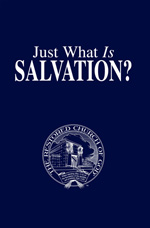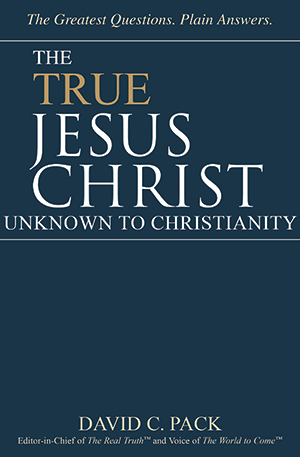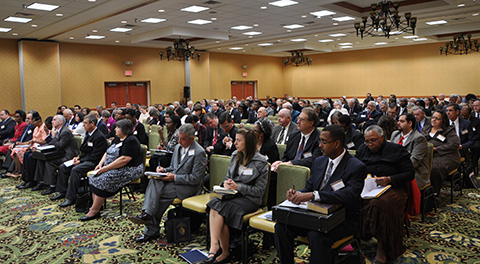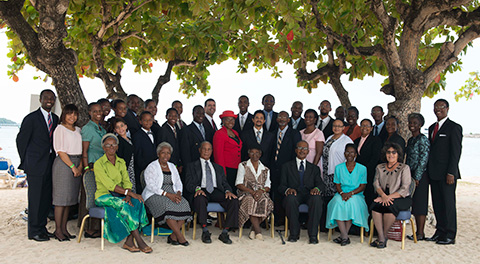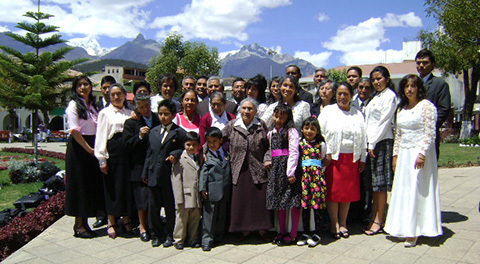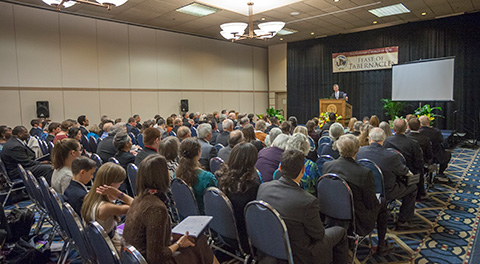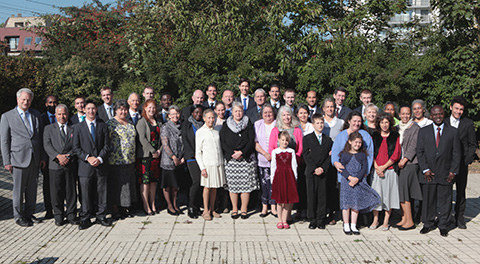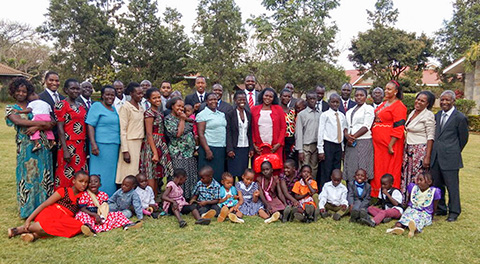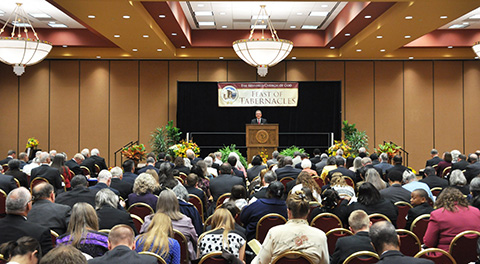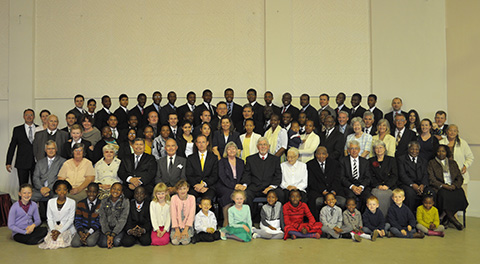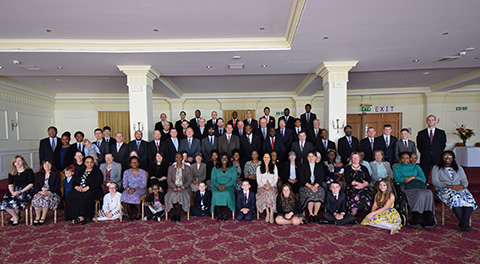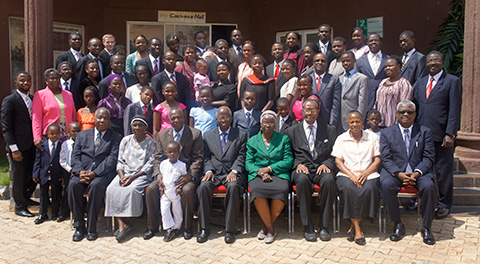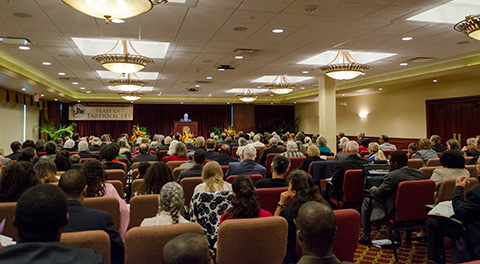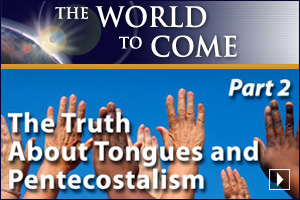More than two billion people claim to worship the God of the Bible and to be followers of Jesus Christ. They worship in divided, competing churches, religious organizations, denominations, groups and movements of varying beliefs, governments and traditions.
Yet Christ said His Church would be a “little flock” (Luke 12:32)—undivided, “perfectly joined together in the same mind and in the same judgment” (I Cor. 1:10)—in “one accord” (Acts 2:46), continuing “steadfastly in the apostles’ doctrine [teaching] and fellowship” (vs. 42)—all speaking the same thing, just as the first-century Church had done.
But today’s professing Christians are divided by doctrine, which is why they do not—and cannot—walk together (Amos 3:3). How can so many churches and their adherents say they are Christian, yet teach opposing beliefs and traditions? Why are so few willing to ask what is wrong?
Again, these churches cannot all be right.
Jesus warned, “Not everyone that says unto Me, Lord, Lord, shall enter into the kingdom of heaven” (Matt. 7:21). He said, “Many will say to Me in that day, Lord, Lord, have we not prophesied in Your name? And in Your name have cast out devils [demons]? And in Your name done many wonderful works? And then will I profess unto them, I never knew you: depart from Me, you that work iniquity” (vs. 22-23).
There are entire television channels devoted to popular religious leaders who preach boldly, as though they carry authority, who claim to heal the sick and cast out demons, who say they are preaching the gospel—but in reality proclaim a message entirely about Christ rather than the good news He declared: the arrival of the kingdom of God!
Of such people, God states, “Her priests have violated My law, and have profaned My holy things: they have put no difference between the holy and profane, neither have they shown difference between the unclean and the clean, and have hid their eyes from My Sabbaths, and I am profaned among them” (Ezek. 22:26).
The so-called ministers and lay members of modern Christendom make a dazzling show of worshipping God—but all in vain.
Manmade Laws, Traditions That Counter God’s Law
In Mark 7, the scribes and Pharisees criticized Christ’s disciples for not ceremoniously washing their hands before eating. The issue wasn’t about hygiene; the Pharisees believed that certain things outside the body (such as accidently eating a speck of dirt or an unclean insect) could defile them in God’s eyes.
But Jesus taught, “That which comes out of the man, that defiles the man. For from within, out of the heart of men, proceed evil thoughts, adulteries, fornications, murders, thefts, covetousness, wickedness, deceit, lasciviousness, an evil eye, blasphemy, pride, foolishness: all these evil things come from within, and defile the man” (vs. 20-23).
As we saw in Chapter Three, to supposedly ensure Judah was never again punished by God for disobedience, religious leaders created numerous meticulous laws, codes and traditions that turned obedience to God’s commandments statutes and laws into an unnecessary burden. For example, they created laws, based on human reasoning, detailing exactly how far one can walk on the Sabbath or exactly how many ears of corn one can pluck before breaking it.
The Pharisees were more concerned with keeping the technical points of God’s laws than with upholding their spiritual application.
Notice: “Woe unto you, you blind guides, which say, Whosoever shall swear by the temple, it is nothing; but whosoever shall swear by the gold of the temple, he is a debtor! You fools and blind: for whether is greater, the gold, or the temple that sanctifies the gold? And, Whosoever shall swear by the altar, it is nothing; but whosoever swears by the gift that is upon it, he is guilty. You fools and blind: for whether is greater, the gift, or the altar that sanctifies the gift? Whoso therefore shall swear by the altar, swears by it, and by all things thereon. And whoso shall swear by the temple, swears by it, and by Him that dwells therein. And he that shall swear by heaven, swears by the throne of God, and by Him that sits thereon” (Matt. 23:16-22).
Also, “For Moses said, Honor your father and your mother; and, Whoso curses father or mother, let him die the death: But you say, If a man shall say to his father or mother, It is Corban, that is to say, a gift, by whatsoever you might be profited by me; he shall be free. And you suffer him no more to do ought for his father or his mother; making the word of God of none effect through your tradition, which you have delivered: and many such like things do you” (Mark 7:10-13).
Jesus warned His disciples that there would come a time when people would kill true Christians in God’s name, sincerely believing they were “do[ing] God service” (John 16:2).
Again, over two billion people attend church services or at least “try to be good” (by their own reasoning); they practice good works, helping the destitute. But in the end, they are not true Christians—not by Christ’s standards! Of such people, He says, “I never knew you.”
Why?
Because all of their good works, all of their efforts in striving to be “good” (at least in a general sense), have been done in vain. “In vain do they worship Me,” Jesus said, “teaching for doctrines the commandments [and traditions] of men” (Mark 7:7). “For laying aside the commandment of God, you hold the tradition of men…Full well you reject the commandment of God, that you may keep your own tradition” (vs. 8-9).
The word “vain” here means “fruitlessly; folly, to no purpose.” Over a billion Christians on Earth pray to God, speak of His Work, and may (to varying degrees) keep God’s commandments—yet, in Jesus Christ’s eyes, all in an empty exercise!
Adding manmade traditions, codes, etc., not approved by God, works against the spiritual application of God’s laws: love (Rom. 13:10). Popular religionists and even politicians say we cannot know God’s will—but the Bible states otherwise (Rom. 12:2). Think: Would Christ command, “Be you therefore perfect [spiritually entire, complete], even as your Father which is in heaven is perfect” (Matt. 5:48), yet not tell us how to achieve perfection or what He meant by becoming “perfect”? Would He tell us to love God and to love our neighbor as ourselves, but not tell us how to achieve this?
Or course not!
Hebrews 1:1-2 states, “God, who at sundry times and in divers manners spoke in time past unto the fathers by the prophets, has in these last days spoken unto us by his Son, whom He has appointed heir of all things, by whom also He made the worlds.” God spoke to His people through Jesus Christ during His earthly ministry; in this sense, Christ was continuing His role as the Word, the Spokesman for the God Family (John 1).
Today, God speaks to us through His written Word, the Bible. A book of truth (John 17:17), it is a “quick [living], and powerful, and sharper than any two-edged sword, piercing even to the dividing asunder of soul and spirit, and of the joints and marrow, and is a discerner of the thoughts and intents of the heart” (Heb. 4:12). If one permits, the Bible will cut through the self-deception of carnal nature (Jer. 17:9), teaching the humble person the Will of God. (See II Timothy 3:14-17.)
True Christians simply allow the Bible to interpret the Bible, and follow what it teaches. Needlessly adding to Scripture extra codes and traditions that supposedly “enhance” God’s Law is vain worship.
“Christianizing” Pagan Beliefs
Every year, the vast majority of professing Christians keep Christmas, Easter and other holidays steeped in ancient pagan rituals. They reason that these popular celebrations have somehow been “Christianized,” turning practices and traditions rooted in idolatry—often once having involved gruesome child sacrifice—into now being approved by God.
But what does the God of the Bible say about these ideas?
After rescuing them from slavery, God warned Israel not to practice the customs they had acquired in Egypt, or to learn the ways and traditions of the Gentile nations they would encounter in the Promised Land (Lev. 18:1-3). Instead, God commanded Israel to follow His ways (vs. 4-5).
Why do so few heed this next passage? “Learn not the way of the heathen, and be not dismayed at the signs of heaven, for the heathen are dismayed by them. For the customs of the people are vain” (Jer. 10:2-3).
But Israel did not listen. “And they have turned unto Me the back, and not the face: though I taught them, rising up early and teaching them, yet they have not hearkened to receive instruction. But they set their abominations in the house [the temple at Jerusalem], which is called by My name, to defile it. And they built the high places of Baal, which are in the valley of the son of Hinnom, to cause their sons and their daughters to pass through the fire unto Molech; which I commanded them not, neither came it into My mind, that they should do this abomination, to cause Judah to sin” (Jer. 32:33-35).
Imagine. Israel committed a sin so vile, so disgusting, that it even shocked God!
Concerning this pagan, satanic system, God commands true Christians to “come out of her, My people, that you be not partakers of her sins, and that you receive not of her plagues” (Rev. 18:4).
God commands His people to follow Him—not the traditions of men. God’s ways are higher, better than man’s (Isa. 55:8-9). Men cannot determine for themselves right from wrong or how to properly worship God.
Why? Because “the way of man is not in himself: it is not in man that walks to direct his steps” (Jer. 10:23). God designed us and gave us life. He knows how we are to worship Him.
To be a true Christian and to properly serve God, one must live “by every word that proceeds out of the mouth of God” (Matt. 4:4), recognizing that His Holy Scriptures “cannot be broken” (John 10:35).
The idolatry-drenched religious holidays and customs of this world seem like sincere, heartfelt sacred observances—but they are deeply rooted in pagan ideas that counterfeit God’s will—and God says He hates them! Pagan observances cannot be “Christianized” or made clean by men. To do so is to worship God in vain.
Vain Repetition
As with all other doctrines in the Bible, “churchianity” has distorted and misapplied Christ’s teaching on how to pray. Misguided theologians have twisted Matthew 6:5-15 and Luke 11:1-4. They have led millions into turning Jesus Christ’s model prayer into a meaningless, word-for-word recitation. This was never Christ’s intention!
In Matthew 6:5-8, Jesus instructed His disciples not to pray to be seen by men and to be considered “righteous.” The Bible teaches that God will listen only to those who are teachable, humble and yielded to Him. Notice Isaiah 66: “Thus says the Lord, The heaven is My throne, and the earth is My footstool: where is the house that You build unto Me? And where is the place of My rest? For all those things has My hand made, and all those things have been, says the Lord: but to this man will I look, even to him that is poor and of a contrite spirit, and trembles at My Word” (vs. 1-2).
Jesus used a parable to teach a valuable lesson to some who “trusted in themselves” (Luke 18:9): “Two men went up into the temple to pray; the one a Pharisee, and the other a publican [tax collector]. The Pharisee stood and prayed thus with himself, God, I thank You, that I am not as other men are, extortioners, unjust, adulterers, or even as this publican. I fast twice in the week, I give tithes of all that I possess” (vs. 10-12). The Pharisee seemed to believe he was God’s gift to mankind.
“And the publican, standing afar off, would not lift up so much as his eyes unto heaven, but smote upon his breast, saying, God be merciful to me a sinner” (vs. 13). The tax collector saw himself from God’s perspective and humbled himself.
Christ continued, “I tell you, this man [the tax collector] went down to his house justified rather than the other: for every one that exalts himself shall be abased; and he that humbles himself shall be exalted” (vs. 14).
God will not listen to the prayers of the proud and arrogant (Jms. 4:6).
In Matthew 6, Jesus also warned His followers about praying in vain repetition—repeating the same words in a monotonous, chant-like drone, as millions of “Christians” do today. Then in verse 9, He states, “After this manner therefore pray…” The Greek word for “manner” is houtos, meaning “in this way.” Christ was not teaching His disciples to follow this prayer word-for-word. Remember, He had just commanded them not to do this in verse 7. In contrast to the popular Jesus, so few pay attention to the One who inspired the Bible.
What Christ was teaching them (and us today) was a prayer outline, or model prayer, with topics to pray about and the general order they should follow. It is up to the person praying to provide details for each subject.
The example of Jezebel and the 450 prophets of Baal (I Kings 18) shows that endlessly babbling prayers is nothing but vain repetition—an empty exercise of communication that will reach no higher than the ceiling.
But contrary to the prophets of Baal, Elijah gave a simple, but earnest, prayer to God, which He answered. Here’s why: “The effectual fervent prayer of a righteous man avails much” (Jms. 5:16)—which brings us to another point.
Obedience, Not Sacrifice
Believe it or not, one can observe God’s Sabbath and annual Holy Days, and keep the letter of the Law—yet all in vain, in a show of empty, meaningless worship!
Regarding the modern descendants of ancient Israel, which God calls “people of Gomorrah,” God states, “To what purpose is the multitude of your sacrifices unto Me? says the Lord: I am full of the burnt offerings of rams, and the fat of fed beasts; and I delight not in the blood of bullocks, or of lambs, or of he goats. When you come to appear before me, who hath required this at your hand, to tread my courts? Bring no more vain oblations [worthless sacrifices]; incense is an abomination unto Me; the new moons and Sabbaths, the calling of assemblies, I cannot away with; it is iniquity, even the solemn meeting. Your new moons and your appointed feasts My soul hates: they are a trouble unto Me; I am weary to bear them. And when you spread forth your hands, I will hide My eyes from you: yes, when you make many prayers, I will not hear: your hands are full of blood” (Isa. 1:11-15).
Most ministers and religionists claim this passage abolishes God’s annual festivals—but that is not what God is condemning. He says, “YOUR new moons and YOUR appointed feasts My soul hates.”
Elsewhere in Isaiah, God charges His faithful servants to warn the modern descendants of Israel of “Jacob’s trouble” (Jer. 30:6-7) because of their religious hypocrisy: “Cry aloud, spare not, lift up your voice like a trumpet, and show My people their transgression, and the house of Jacob their sins.” (Isa. 58:1).
Many of today’s 600 million-plus people of modern Israel (who are unaware of their prophetic identity) believe they faithfully worship God, while they endlessly sprint through Our Father and Hail Mary “prayers.” They volunteer in soup kitchens and other charities for the needy. They teach the “golden rule” of treating others properly. Yet all their works are in vain—because they do so their way, according to their terms.
God declares that “Yet they seek Me daily, and delight to know My ways, as a nation that did righteousness, and forsook not the ordinance of their God: they ask of Me the ordinances of justice; they take delight in approaching to God” (Isa. 58:2). They appear to be righteous, but they actually wear the clothes of SELF-righteousness, claiming to be God-fearing people while ignoring Proverbs 8:13: “The fear of the Lord is to hate evil: pride, and arrogancy, and the evil way, and the froward [perverse] mouth, do I hate.”
God charges His servants to deliver His end-time warning to Jacob—but the reaction they receive is shallow: “And they come unto you as the people come, and they sit before you as My people, and they hear your words, but they will not do them: for with their mouth they show much love, but their heart goes after their covetousness. And, lo, you are unto them as a very lovely song of one [Hebrew: A good singer] that has a pleasant voice, and can play well on an instrument: for they hear you words, but they do them not” (Ezek. 33:31-32).
These same people arrogantly ask of God, “Wherefore have we fasted…and You see not? Wherefore have we afflicted our soul, and You take no knowledge?” (Isa. 58:3).
God answers, “Behold, in the day of your fast you find pleasure, and exact all your labors. Behold, you fast for strife and debate, and to smite with the fist of wickedness: you shall not fast as you do this day, to make your voice to be heard on high” (vs. 3-4).
He adds, “Is not this the fast that I have chosen? To loose the bands of wickedness, to undo the heavy burdens, and to let the oppressed go free, and that you break every yoke? Is it not to deal your bread to the hungry, and that you bring the poor that are cast out to your house? When you see the naked, that you cover him; and that you hide not yourself from your own flesh?” (vs. 6-7). And that “you turn away your foot from the Sabbath, from doing your pleasure on My holy day; and call the Sabbath a delight, the holy of the Lord, honorable; and shall honor Him, not doing your own ways, nor finding your own pleasure, nor speaking your own words” (vs. 13).
In other words, put Christianity into action God’s Way, not your own!
Even after witnessing God’s punishment of deporting the house of Israel into national slavery, Judah thought it could not happen to them. After all, they reasoned, Israel changed God’s Holy Days and worshipped idols and false gods. But Jerusalem had Solomon’s Temple, the Levitical priesthood and the daily sacrifices.
Nonetheless, having the Temple did not wipe away Judah’s secret sins. It did not save them from being punished for appearing to be faithful while in reality they were rebellious. Read Ezekiel 8, in which seemingly righteous religious leaders privately worshipped false gods. Verses 13-16 reveal that, while claiming to serve God, people actually worshipped Tammuz and the sun—ancient pagan practices known today as “Easter”! (This will be covered in more detail momentarily.)
But God said, “For I desired mercy, and not sacrifice; and the knowledge of God more than burnt offerings” (Hos. 6:6)—and “to obey is better than sacrifice” (I Sam. 15:22).
“Wherewith shall I come before the Lord, and bow myself before the high God? Shall I come before him with burnt offerings, with calves of a year old? Will the Lord be pleased with thousands of rams, or with ten thousands of rivers of oil? Shall I give my firstborn for my transgression, the fruit of my body for the sin of my soul? He has showed you, O man, what is good; and what does the Lord require of you, but to do justly, and to love mercy, and to walk humbly with thy God?” (Mic. 6:6-8).
To worship and serve the true God requires rejecting one’s human nature—which is self-deceptive (Jer. 17:9; Prov. 16:25), hostile toward God (Rom. 8:7), and cannot subject itself to God’s Law (same verse). It means praying to, obeying and serving Him HIS way.
Anything less is to worship God in vain.
“Another Jesus”?
Paul warned those of his day—and forewarned all later generations—of a clever counterfeit facing the early Church—one that is directly, yet subtly, related to vain worship: “For if he that comes preaches another Jesus, whom we have not preached, or if you receive another spirit, which you have not received, or another gospel, which you have not accepted, you might well bear with him” (II Cor. 11:4).
The Greek word translated “another” in this verse is allos, meaning “different.” Paul warned of a different Jesus—not the One of the Bible, not the only begotten Son of God, but an impostor.
In other words, the “another Jesus” is NOT the true Jesus
Paul, who was inspired by the true Jesus Christ of the Bible, was moved to record the peril of unwittingly following “another Jesus.” Whomever you may think this false Jesus to be—and most have probably never remotely considered the idea for even a moment—there is such a thing as a wrong, different and false Jesus—called “another Jesus.” The subtlety of how this can occur, and how it has occurred in history, is so deceptive—so seductive—that even true Christians can unknowing slip into worshipping this so-called Jesus. This was happening to the Corinthians.
Millions maintain a pretense of Christianity, but it is only a façade, of whom Paul described as “having a form of godliness, but denying the power thereof” (II Tim. 3:5). For them, the final authority in matters of faith and moral behavior is not the Word of God, but the inner workings of the human mind. Some denominations view the Bible as merely a historical document requiring human interpretation to correct its “errors.”
People unknowingly worship in ways that are far different from what they sincerely believe or intend. When one does not understand the “simplicity in Christ” (II Cor. 11:3) and allow the Bible to interpret itself, the inevitable result is to soon be unwittingly following a different savior (vs. 4).
The “Jesus” commonly spoken of in the large denominations of accepted Christianity promotes the idea that obeying God’s divine laws is no longer needed because they were “nailed to the cross.” All a Christian must do is “accept and believe in Him” to be assured a place in heaven. Because of such false ideas, the majority of believers reject the seventh-day Sabbath, the annual Holy Days and other truths of the Bible, leaving an open door for a host of non-biblical practices that God calls abominations.
Paul foretold a time when fables and the traditions of men would be substituted for the truth: “For the time will come when they will not endure sound doctrine; but after their own lusts shall they heap to themselves teachers, having itching ears; and they shall turn away their ears from the truth, and shall be turned unto fables” (II Tim. 4:3-4).
This deception began in the first century, but has grown much worse in recent times. Most receive teachers who tell them what they want to hear rather than what they need to hear. Wrong conduct is justified—explained away—giving no regard to the warning, “Woe unto them that call evil good, and good evil; that put darkness for light, and light for darkness; that put bitter for sweet, and sweet for bitter!” (Isa. 5:20). God does not take lightly those who place their view of His laws and way of life in place of HIS view.
Paul wrote of “another gospel” and “another spirit,” appearing in conjunction with this “another Jesus.” History reveals that traditional Christianity brought in a different Jesus. And with him came a different gospel, a social gospel of “love” and “tolerance”—one that does not require any personal responsibility, such as repentance. Its message is “come as you are” and “believe on Jesus” to receive salvation.
Today, everyone hears much about the person of Jesus Christ—confining the message solely to the things about the Son of God, but not about the message He brought: the kingdom of God, the only government that will bring universal peace, security, abundance and prosperity to all nations and peoples. Sadly, millions believe on Jesus, but do not actually believe Him—they do not DO what He taught!
The master counterfeiter (Satan the devil, who we have seen is called the “god of this world” in II Cor. 4:4) seeks to counterfeit every aspect of God’s plan. We have seen that he “deceives the whole world” (Rev. 12:9). As the arch-deceiver, he would not be content to counterfeit all other aspects of Christianity but not the identity and worship of the true Savior!
You are about to learn of the astonishing parallel between the “saviors” found throughout ancient religion and the popular “savior” worshipped today in Christendom. It is also a fact that these ancient counterfeit saviors were often worshipped in conjunction with springtime festivals of renewal. The modern face of these festivals is the pagan Easter celebration.
Easter—Condemned in the Bible!
It will come as a surprise to most that Easter is mentioned repeatedly in the Bible—but never in a good context. In fact, God condemns the custom in the strongest possible terms. We will see that Easter is interwoven with the worship of Baal and sun worship.
Before concluding that this cannot be true, force yourself to consider the facts of history. It is vital to understand the origin of Easter, and its connection to the Jesus worshipped by millions, because this spring celebration is considered the holiest in the Christian calendar.
So then, who or what is Easter? From where does this term derive?
The following sources answer the question: “What means the term Easter itself? It is not a Christian name. It bears its Chaldean origin on its very forehead. Easter is nothing else than Astarte, one of the titles of Beltis, the queen of heaven…Now, the Assyrian goddess, or Astarte, is identified with Semiramis by Athenagoras (Legatio, vol. ii. p. 179), and by Lucian (De Dea Syria, vol. iii. p. 382)…Now, no name could more exactly picture forth the character of Semiramis, as queen of Babylon, than the name of ‘Asht-tart,’ for that just means ‘The woman that made towers’…Ashturit, then…is obviously the same as the Hebrew ‘Ashtoreth’” (Alexander Hislop, The Two Babylons, pp. 103, 307-308, emphasis ours).
Notice this conclusive quote from Microsoft Encarta Multimedia Encyclopedia: “Ishtar was the Great Mother, the goddess of fertility and the queen of heaven.” In Jeremiah 7:18, God condemned baking cakes (hot cross buns) to the “queen of heaven.” So, in actuality, Ashtaroth (Ishtar) was Nimrod’s (Gen. 10:8-10) harlotrous, mother/wife widow, Semiramis, as many other ancient historians attest! Easter is none other than Ashtaroth! More proof will follow, but we can now examine the scriptures that show how God views the worship of this pagan goddess—by any name.
Easter, Baal and Israel
Now that we know that Easter is the goddess Ashtaroth, we need to look into the Bible and see what God thinks of her, and notice her connection to Baal.
This first of two sources about Baal comes from Encyclopaedia Britannica, and it begins to connect Baal to Ashtaroth: “The Semitic word baal, meaning owner or master, was also used in ancient religions for lord or god, and it is still defined as a Canaanite or Phoenician deity. Among the greatest of the Semitic peoples’ deities were Baal and Astarte—both symbols of fertility. Baal, the god of the sun, was supposed to make crops grow and flocks increase. Astarte [was] the goddess of the moon…”
Now read this quote from The Columbia Electronic Encyclopedia, Sixth Edition: “Baal had become the ruler of the universe. The Ugarit tablets make him chief of the Canaanite pantheon. He is the source of life and fertility, the mightiest hero, the lord of war, and the defeater of the god Yam. There were many temples of Baal in Canaan, and the name Baal was often added to that of a locality, e.g., Baal-peor, Baal-hazor, Baal-hermon. The Baal cult penetrated Israel and at times led to syncretism…The practice of sacred prostitution seems to have been associated with the worship of Baal in Palestine and the cult was vehemently denounced by the prophets…” (emphasis ours).
Baal was the most popular and powerful god of his time, considered to be “ruler of the universe,” and Israel wanted to be associated with—to worship—both Baal and the true God. Hence, the above reference to “syncretism,” which is the mixing of true and false religion—the worship of the true God mixed with customs, practices and worship of other gods.
Merging worship of the true God with Baal worship was Israel’s problem. It led Elijah to indict all Israel: “How long halt you between two opinions? If the Lord be God, follow Him: but if Baal, then follow him. And the people answered him not a word” (I Kgs. 18:21).
Now let’s examine Israel’s involvement with Baal and Ashtaroth: “And the children of Israel did evil in the sight of the Lord… And they forsook the Lord, and served Baal and Ashtaroth [Easter]” (Judges 2:11, 13).
The context of the passage shows that God allowed His people to be taken from their land into foreign captivity as a result of this sin! It continues, explaining that God delivered His people over and over again through a series of judges. After each deliverance, Israel returned to the same false gods, which in turn brought another captivity, via conquest by the nations around them. They never seemed to learn, as verse 19 makes clear: “And it came to pass, when the judge was dead, that they returned, and corrupted themselves…in following other gods…and…they ceased not from their own doings, nor from their stubborn way.” In chapter 10, verse 6, Israel repeats this pattern of rebellion and stubbornness. And God, just as insistently, called it evil—as He still does today.
Baal and Ashtaroth worship reappeared during the prophet Samuel’s time. Samuel told Israel, “…put away the strange gods and Ashtaroth from among you, and prepare your hearts unto the Lord, and serve Him only…Then the children of Israel did put away Baalim and Ashtaroth, and served the Lord only” (I Sam. 7:3-4). Later, in I Samuel 12:10-11, Samuel publicly recounted Israel’s history to them. He reminded them that they continually returned to obeying God, only to fall backward into idolatry time and time again!
Let’s read one final example. The Bible states that King Solomon was the wisest man who ever lived. Yet, he made a mistake God considered so great that, after his death, He punished Solomon by removing the kingdom from his son.
His mistake?
Solomon married a Gentile “stranger” who led him into the worship of Easter (Ashtaroth). Notice I Kings 11:4-6: “For it came to pass, when Solomon was old, that his wives turned away his heart after other gods…For Solomon went after Ashtaroth the goddess of the Zidonians…And Solomon did evil in the sight of the Lord, and went not fully after the Lord, as did David his father.” Verses 11-12 demonstrate that the kingdom was, in fact, taken from his son.
God considered worship of this goddess as outright “evil.” This was even though Solomon was only “not fully” seeking the true God.
It has been said, “The only thing man has learned from history is that no one learns from history.” George Santayana took it further, stating, as we saw, “Those who do not learn the lesson of history are doomed to repeat it.”
This lesson describes ancient Israel—but it also describes today’s modern world. Because Israel could not stay on track, they were eventually taken into captivity, eventually becoming lost to history! (After one more captivity and punishment, prophecy reveals that God will gather them from a final, coming captivity.)
This paragraph requires far too much explanation for this book. In fact, it requires its own full book to explain—America and Britain in Prophecy. You have never read anything like it.
What History Reveals
We are now prepared to examine the astonishing record from history, and allow it to expose the popular “another Jesus” worshipped today for who he really is. Prepare to be stunned—and, hopefully, even more deeply motivated to act upon all that you are learning!
First, there is this: “…the conception of a Saviour-God was quite normal in the ancient pagan world…a conception of salvation underlies the notion of such Gods as Osiris, Attis, and Adonis…” (John M. Robertson, Christianity and Mythology, p. 395).
And then this incredible admission: “It has often been urged that this belief in the Resurrection of Jesus is due to ideas of divine resurrection current in the contemporary world…stories of Attis, Adonis, and Osiris…In the pagan stories the rising again is a joyous reversal of defeat; in the Christian story it is the complement of victorious death. It may be said that Attis and Osiris saved by rising again, Jesus by dying…the Easter observance did not arise at once out of belief in the Resurrection, but developed later by gradual stages out of the Jewish Pasch. The notion implied in the Easter greeting Christ is risen is a secondary development; the idea comes from this festival and from its occurrence in spring; the festival does not come from the idea. The idea of Christ’s resurrection was injected into the old practice of Easter observance and not the other way around” (A. Nock, Early Gentile Christianity and its Hellenistic Background, pp. 105-107, emphasis ours throughout).
The powerful theme of this oft-repeated counterfeit is made absolutely clear by the famous historian, James George Frazer: “Now the death and resurrection of Attis were officially celebrated at Rome on the 24th and 25th of March, the latter being regarded as the spring equinox, and…according to an ancient and widespread tradition Christ suffered on the 25th of March…the tradition which placed the death of Christ on the 25th of March…is all the more remarkable because astronomical considerations prove that it can have had no historical foundation…When we remember that the festival of St. George in April has replaced the ancient pagan festival of the Parilia; that the festival of St. John the Baptist in June has succeeded to a heathen Midsummer festival of water; that the festival of the Assumption of the Virgin in August has ousted the festival of Diana; that the feast of All Souls [Halloween] in November is a continuation of an old heathen feast of the dead; and that the Nativity of Christ himself was assigned to the winter solstice in December because that day was deemed the Nativity of the Sun; we can hardly be thought to be rash or unreasonable in conjecturing that the other cardinal festival of the Christian church—the solemnization of Easter—may have been in like manner, and from like motives of edification, adapted to a similar celebration of the Phrygian god Attis at the vernal equinox…It is a remarkable coincidence…that the Christian and the heathen festivals of the divine death and resurrection should have been solemnized at the same season…It is difficult to regard the coincidence as purely accidental” (The Golden Bough, Vol. I, pp. 306-309, emphasis ours).
While very extensive, this next and final source is perhaps the most powerful—and the most fascinating to understand. Let its message crash on your ears: “The similarity of ancient pagan legends and beliefs with Christian traditions was so great that they excited the attention and undisquised [sic] wrath of the early Christian…not knowing how to explain it. Tertullian said, ‘The Devil, by the mysteries of his idols, imitates even the main part of the divine mysteries.’ Furthermore Cortez, too, complained that the Devil had possibly taught the Mexicans that same thing that God taught Christendom. The common idea is that pagan gods fled away at Christ’s coming, yet it is well known to every Bible student [that] this is contrary to fact. At the time of the recorded appearance of Jesus, and for some centuries before, there were temples without dedicated to Apollo or Dionysius among the Greeks, or Hercules among the Romans, Mithra among the Persians, Baal and Astarte among the Babylonians, and temples dedicated to other gods. An outstanding phenomenon is apparent: notwithstanding great geographic distance, racial difference between cults and in detail of services, the general outline of creeds and ceremonies were—if not identical—markedly similar.
“A fact that cannot be considered coincidental is, that of 11 main deities from the seven countries, it was believed of all or nearly all that these deities’ births were on or near Christmas, of a virgin mother, in a cave underground, that they led a life of toil for man. They were thought to have been light bringers, healers, mediators, and into saviors. They were vanguished [sic] by the power of darkness, descended into hell or the underworld, to have arisen to become pioneers of mankind to a heavenly world…Krishna [part of the Hindu trinity], the god of India is an outstanding example of a parallel with the life of Christ. The idea of God sacrificing his son for the salvation of the world is so remote and remarkable—yet it ranges through all ancient religion and back to the earliest times and is embodied in their rituals” (Edward Carpenter, Pagan and Christian Creeds).
We can summarize the last two sources. The universal church at Rome often incorporated pagan festivals—pasting Christian-sounding names over them and calling them “Christian.” This was done to make Christianity more palatable and familiar to heathen worshippers, whom the Church was trying to attract. It became easy—natural—for the masses who accepted Christianity to be permitted to bring the familiar customs, traditions and beliefs about their own “savior” into worship of the new “savior,” from then on to be referred to as “Jesus Christ.”
While there is not space in this chapter to thoroughly cover the entire history and origin of this different “Jesus,” a brief summary, followed by one more revealing statement from history, is helpful.
The Mother and the Savior
Semiramis (Easter) was both the mother and wife of Nimrod, described in Genesis 10:8-10, who was the great-grandson of Noah and the original Baal. In a blatant attempt to rebel against God shortly after the Flood—and the Tower of Babel was built so that civilization would be impervious to “any other flood that God might bring”—history shows that this mother/son duo appointed themselves as gods to be worshipped. History also records that Noah’s son Shem (Nimrod’s great-uncle) eventually tracked down and killed Nimrod, and sent his body parts throughout his kingdom. (This is also what happened to Osiris, the “father” in the Egyptian trinity with Horus and Isis.) Semiramis fled for her life, only to return 30 years later with her younger son, Horus (the son in the Egyptian trinity), whom she said was born supernaturally and was the reincarnation of Nimrod—the resurrected savior! Nimrod was Horus’ supposed father, and Semiramis claimed that she had immaculately conceived him. She also claimed that she came from the moon in a giant egg that fell into the Euphrates river and that this occurred after the spring equinox on the first full moon. This moon egg was known as Ishtar’s (pronounced Easter’s) Egg. She reinstituted worship of herself and Nimrod, calling herself the mother of god and queen of heaven, among other things, by saying that Nimrod symbolized the sun as it “died” during the long cold winter. She also taught that Nimrod was resurrected, and that his son Horus was resurrected to join him in heaven, and Nimrod’s resurrection was represented by the sun returning each spring to warm the Earth and renew life.
While there is much more to the story than can be included here, Semiramis’ new “mystery system” eventually spread to all peoples of the Earth, as the earlier sources reveal.
Now notice this from the Creation Epic, speaking of Nimrod, the original “savior” of the world: “As for us, by however many names we call him, he is our god! Let us proclaim his 50 names…”
Here are some of them from history, many of which God condemned Israel for having followed: Nimrod, Molech, Chemosh, Baal, Milcom, Bacchus, Dagon, Osiris, Saturn, Adonis, Cupid, Apis, Volcon, Attis, Kronos and Tammuz, the son in the Babylonian trinity with Ninas (Nimrod) and Ishtar (Easter). (Ezekiel 8:14-16 directly connects Tammuz—the resurrected son of, and reincarnation of, Nimrod—to sunrise services and sun worship, which God calls there an abomination.)
It can now be better understood why the apostle Paul wrote the Corinthians to beware of the subtle deceit of “another Jesus whom we have not preached.” The original apostles understood that “another” very different “Jesus” whom they had “not preached” had existed for millennia.
Bible “believers” today can think that they are worshipping the true Savior when they are really worshipping a false savior—“another Jesus”!
Understand. The entirety of traditional Christianity is worshipping Baal, the mediator and sun god, who was named after his “wife” Ishtar (who we have seen was really his mother Semiramis).
The modern mother/child “Mary/Jesus” emphasis, including the worshipful adoration of Mary by millions, is a parallel with Semiramis and Nimrod that cannot be missed, even at a cursory glance.
“Another Jesus”—Brought by “Another Spirit”
This chapter, and in fact the whole book, is not complete without some summary understanding that ties together what it means to correctly identify the true Jesus—the real Christ—of the Bible.
We have seen that professing Christianity unwittingly worships a false Jesus (“another Jesus”), who brings with him a false gospel about the Person of Jesus Christ. Now pause and grasp the additional seriousness of what else bringing another “gospel” means—the grave danger of what is actually being brought for worship with this revised “gospel.” The reader must understand why God places a curse (see Gal. 1:8-9) on those who pervert the gospel—those who blur or confuse His literally “Genesis-to-Revelation” announcement about His coming world-ruling supergovernment.
The attempt to bring “Jesus” into the gospel derives from a much greater danger, not only that of “another Jesus,” but one born of “another spirit.” In the first century, we saw that some in the Corinth congregation began to believe “another gospel” and “another Jesus,” and did not recognize that these were connected to a third problem—that of following “another SPIRIT.”
In I John 4:6, the apostle John labels this alien spirit the “spirit of error,” and contrasts it to the “Spirit of truth.” Take a moment to read this verse. It is this spirit of error that is guiding the churches of professing Christianity in its many denominations and branches—and this spirit is connected to a counterfeit “body of Christ.”
Recognize the gravity of this knowledge. Understand why it is absolutely vital to get this point clear in your mind!
Extreme Danger!
Another critically important element ties in here, and is connected directly to the Church that Christ has built (Matt. 16:18)—the only Church where the true Christ is leading His Work, and the true gospel is being preached. The living Jesus Christ has always worked exclusively leading only one, unified, organized, uncompromising Church—the biblical Body of Christ.
As we read in Chapter Fourteen, the “Christian” world teaches that the Body of Christ—Jesus’ Church—consists of many denominations, fellowships or “communities of believers,” said to all be connected by the “Holy Spirit” working in believers wherever they are affiliated. And we saw the many scriptures explaining the truth of what the Bible teaches about the Body of Christ.
Here is what the reader must be able to recognize: The entire professing Christian world believes in a different (counterfeit) “body” of a different (counterfeit) “Christ,” emanating from an entirely different (counterfeit) “spirit” that is NOT the Spirit of God. All of these confused, competing churches are led by the “spirit of disobedience” that is plainly identified in Ephesians 2:2—and shown to be sent from the now understood “god of this world”!
Spirit of Disobedience
Let’s now examine the central “earmark” that will always reveal to the discerning observer where the “spirit of disobedience” is at work. This phrase is in the context of Paul reminding the Ephesian congregation how they had come out of a different way of life—described as the “course of this world”—in which they had been under the sway of the “prince of the power of the air.”
First notice this: “Wherein in time past you walked according to the course of this world, according to the prince of the power of the air, the spirit that now works in the children of disobedience” (2:2).
We now go full circle from the beginning of the chapter—and in one sense the whole book. Disobedience is the opposite of obedience, and obedience is something that one either displays toward God, or does not. One either obeys God’s Law—the Ten Commandments!—or, no matter the reasons he may have or his underlying “theology,” he disobeys it!
We saw that almost all of the professing Christian world teaches that God’s Law—His Commandments—were “nailed to the cross” by Jesus (now seen to be another one) through His sacrifice. We also saw that thousands of preachers tell hundreds of millions of parishioners every Sunday that “that Old Testament Law” has been “done away” by Christ. They are routinely told, “You do not need to keep it. It was kept for you by Jesus.”
And we also saw that millions believe them!
But Romans 8:7 has explained to the reader that human beings are naturally hostile to God and His Law. The terrible fruits of that disobedience are the tragic record of humanity’s last six millennia.
The true Jesus Christ taught His disciples, “If you will enter into life, keep the commandments” (Matt. 19:17). We saw that it is these very commandments that define the love of God, and this is made plain by Romans 13:10 and I John 5:3. While the world speaks endlessly of “love” with its “Jesus,” it is not the real love of God that the Bible describes. The “Jesus” of this world brings a very different message about the importance of law-keeping than that of Matthew 19:17, Romans 13:10, I John 5:3 and many more passages in the New Testament that could be cited.
By now it should be understood that the “prince of the power of the air” is the same as the “god of this world,” the “spirit of error,” “another spirit” and the “spirit of disobedience.” Obviously, this “god”—and spirit—is Satan the devil. Of course, Satan would never actually reveal himself as the devil, or by any of Paul’s inspired descriptions of him referenced here. Almost none would follow him if he did.
The devil has hidden his true identity under the guise of the triune god.
This very different spirit drives the thinking of all modern theology. Under the “power” of this spirit—and Paul shows that this god does have real power—theologians have devised the concept of the trinity. These have cast off the commandments of God, the first four of which would have insulated and protected them—and all humanity—from all false gods and the resultant error—and endless troubles—that come from following them—and from worry about following the wrong Jesus.
Therefore, it is absolutely imperative to the “god of this world” who stands behind the trinity (and the “Jesus” woven within it) that its adherents not return to commandment-keeping! He must, at all costs, try to prevent people from returning to the only Law that will lead them away from him to the true God—and the true Christ! Recognize that disobedience is the central feature in how Satan’s “voice” is identified.
Grasp this. Satan is the spirit behind the almost universally accepted false god known as the trinity! When fully understood, those who believe that God is three-in-one—Father, Son and Holy Spirit—are worshipping another Jesus!
(The subject of the popular triune god is much too large for this chapter, and requires its own thorough book to fully explain and document. You are urged to read The Trinity – Is God Three-In-One?)
The “Voice of Christ”
One final towering fact. The true Jesus Christ of the Bible taught that His sheep “know His voice” (John 10:4). Later in John, Jesus stated, “Everyone that is of the truth hears My voice” (18:37). The voice of Christ is here defined as TRUTH!
The true Christ’s sheep know—can discern—the true Christ’s voice, and can distinguish it from the “voice of a stranger,” which is synonymous with the voice of “another Jesus” and the ministers who represent him.
Get this straight! The spirit of the true Christ, who taught the only true gospel, does not direct the “churches” and “works” of those worshipping another Jesus inside the trinity, who, again, is part of another gospel, derived from another spirit, all of which appears with another counterfeit “body of Christ”—the disobeying, divided, disagreeing, competing confusion that is thought to be bona fide, real Christianity.
The true Christ’s voice is in part directly identified with its emphasis on commandment-keeping, and this must never be forgotten in light of all that you have come to understand throughout this book!
This has been repeated over and over in different ways for emphasis. This is so the reader can see the clear connection between the fundamental elements of the true Jesus Christ—and true Christianity—in contrast to the counterfeits of each.
Read and reread all that you have seen here until it becomes crystal clear in your mind—until it is impossible to misunderstand what is at stake in which church you attend. Remember, the true Christ is not divided (I Cor. 12:13)—meaning there is only one true Church of God! Until you find that Church—the one, unified Body of Christ—you cannot have contact with the living Christ who heads it—and only it!
As Corinth attests, this wrong but subtle teaching about the counterfeit Jesus and his “body” is so clever, so seductive, so elusive to those who do not examine it closely, that it has even fooled many of God’s people—those of Christ’s true Church—through the ages.
Chapter Six explained that the problem in Corinth was traced to brethren there listening to false ministers. Almost immediately after warning of a false Jesus, gospel and spirit, Paul identified this problem, explaining how they had been fooled. Notice a final time: “For such are false apostles, deceitful workers, transforming themselves into the apostles of Christ. And no marvel; for Satan himself is transformed into an angel of light. Therefore it is no great thing if his ministers also be transformed as the ministers of righteousness; whose end shall be according to their works” (II Cor. 11:13-15).
Human beings can worship in ways that represent things very, very different from what they sincerely believe or intend. Not everything is as it seems.
Sadly, the ministers of mainstream Christianity—all of them—preach “another Jesus” and subsequently “another gospel,” leading vast millions astray from worshipping and obeying the true God. As a result, their religious practices and traditions are carried out in vain.
So says God in His Word!

